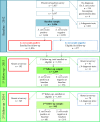Ivermectin Treatment and Sanitation Effectively Reduce Strongyloides stercoralis Infection Risk in Rural Communities in Cambodia
- PMID: 27548286
- PMCID: PMC4993485
- DOI: 10.1371/journal.pntd.0004909
Ivermectin Treatment and Sanitation Effectively Reduce Strongyloides stercoralis Infection Risk in Rural Communities in Cambodia
Abstract
Background: Strongyloides stercoralis is the only soil-transmitted helminth with the ability to replicate within its host, leading to long-lasting and potentially fatal infections. It is ubiquitous and its worldwide prevalence has recently been estimated to be at least half that of hookworm. Information on the epidemiology of S. stercoralis remains scarce and modalities for its large-scale control are yet to be determined.
Methodology/principal findings: A community-based two-year cohort study was conducted among the general population in a rural province in North Cambodia. At each survey, participants infected with S. stercoralis were treated with a single oral dose of ivermectin (200μg/kg BW). Diagnosis was performed using a combination of the Baermann method and Koga agar plate culture on two stool samples. The cohort included participants from eight villages who were either positive or negative for S. stercoralis at baseline. Mixed logistic regression models were employed to assess risk factors for S. stercoralis infection at baseline and re-infection at follow-up. A total of 3,096 participants were examined at baseline, revealing a S. stercoralis prevalence of 33.1%. Of these participants, 1,269 were followed-up over two years. Re-infection and infection rates among positive and negative participants at baseline were 14.4% and 9.6% at the first and 11.0% and 11.5% at the second follow-up, respectively. At follow-up, all age groups were at similar risk of acquiring an infection, while infection risk significantly decreased with increasing village sanitation coverage.
Conclusions/significance: Chemotherapy-based control of S. stercoralis is feasible and highly beneficial, particularly in combination with improved sanitation. The impact of community-based ivermectin treatment on S. stercoralis was high, with over 85% of villagers remaining negative one year after treatment. The integration of S. stercoralis into existing STH control programs should be considered without further delay.
Conflict of interest statement
The authors have declared that no competing interests exist.
Figures



References
Publication types
MeSH terms
Substances
LinkOut - more resources
Full Text Sources
Other Literature Sources

